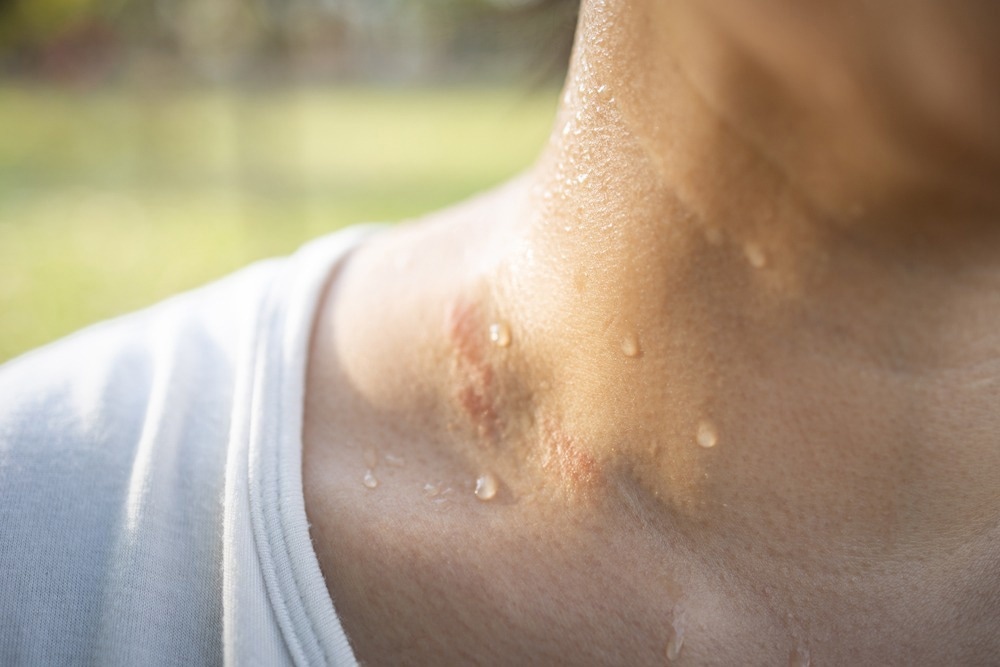In a recent perspective published in Science, researchers explored microfluidic systems with a skin interface in assessing chemical exposure and health status.
 Study: Sweat as a diagnostic biofluid. Image Credit: CGN089/Shutterstock
Study: Sweat as a diagnostic biofluid. Image Credit: CGN089/Shutterstock
Background
The skin's eccrine sweat glands are essential elements of an ingenious evaporative cooling system. Their action is regulated in an adaptive and closed-loop fashion by the sympathetic nervous system to maintain thermal homeostasis during mental and physical strain or high-temperature exposure. In addition to removing heat, perspiration also aids in the elimination of various substances and metabolites.
Recent technological improvements have enabled the use of eccrine sweat for diagnosis, as soft microfluidic analysis systems that stick gently to the skin to allow in situ collection, storage, and biochemical assessment of microliter samples obtained directly from the skin.
Eccrine glands for sweat analysis
In most cases, eccrine glands account for the highest volume of sweat loss. Eccrine glands are found in every region of the human body. The apoeccrine and apocrine glands, the other two major sweat gland types in the dermis, generate sweat with a relatively complicated and varying chemical composition.
In addition, this sweat is produced from particular anatomical locations that are difficult to reach because of their position and hair coverage. These factors motivate the selection of eccrine glands as the primary focus of sweat analysis.
An overview of sweat analysis
For sweat analysis, sweat is collected and stored noninvasively while avoiding contamination, discomfort, and other problems associated with biofluids, including tears, saliva, and urine. Yet, the need for specialized equipment, competent professionals, and stringent protocols has limited sweat's applicability in routine diagnostics.
Without the requirement for experienced staff, microfluidic patches can provide real-time, easy, cost-effective, as well as noninvasive analysis in practically any environment. Typically, these devices are designed to detect a particular or limited collection of molecules instead of the broad range of sweat components. However, in situ assessment of sweat specimens could be employed for a wide range of medically relevant applications, such as disease screening for cystic fibrosis, the management of kidney disorders, tracking of stress levels, the monitoring of the immune system, and the guidance of the usage of prescription medications.
Skin-interfaced microfluidic devices
These devices utilize the natural pumping action employed by the eccrine glands, which originates in secretory coils connecting via tubular lumen to ducts across the dermis and the epidermis and terminates at the skin surface.
The activation of the eccrine glands by cholinergic nerve endings surrounding these secretory coils leads to calcium ion influx into the surrounding cells. This further results in the transport of sodium and calcium ions into the lumen. An elevation in the sodium chloride concentration compared to that of the interstitial spaces and surrounding cells generates an osmotic pressure gradient that forces water into the lumen, finally appearing as sweat that leaves the skin pores.
The rates and amounts of perspiration are determined by fundamental factors of health and hydration. Additionally, active and passive transport pathways result in various chemical constituents, including electrolytes, hormones, metabolites, proteins, medicines, nutrients, heavy metal toxins, and organic pollutants.
Diagnostic assessment according to the concentrations of these components can benefit from sweat rates. Furthermore, diagnostic examinations necessitate exact information on sweat rates, body temperature, accumulated sweat loss volumes, cardiopulmonary activity, and physical exertion.
Recent developments
Flexible and soft microfluidic systems can create durable, watertight interfaces with the skin. This is achieved as these skin patches gather perspiration as it emerges directly from the skin's pores, traveling via inlet ports present at the device's base through a network of microvalves and microchannels to reach micro reservoirs where they are stored and/or assessed. The gadgets enable sweat release dynamics to be measured. Measuring regional sweat rate as well as accumulated sweat volume permits tracking of whole-body data for determining electrolyte and other chemical components lost by sweating.
Chemical tests and fluorometric and colorimetric indicators can provide quantitative analyses of sweat loss, chemistry, and dynamics. Chemistry that responds to sweat biomarkers via alterations in either color or fluorescence intensity. These alterations enable quantitative assessments by analyzing digital images captured from transparent sections of microfluidic systems. Biomarkers assessed include ammonia, creatinine, chloride, glucose, vitamin C, lactate, urea, and sodium.
Conclusion
The perspective showed that sweat could serve as a binary indicator for exposure to external chemical species. However, several aspects of the link between blood chemistry and sweat are poorly understood. The researchers believe future studies could focus on established and newly found sweat biomarkers, expanding therapeutic application choices.